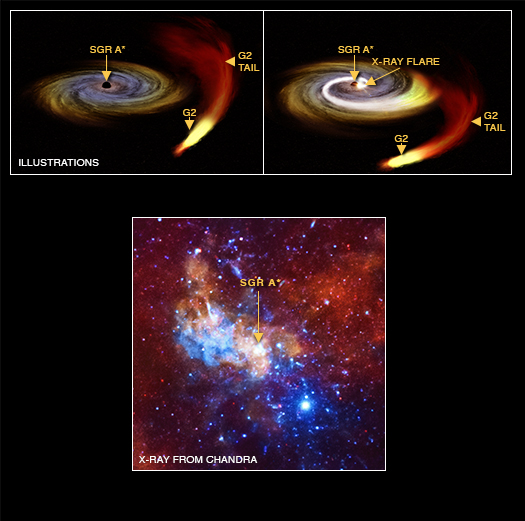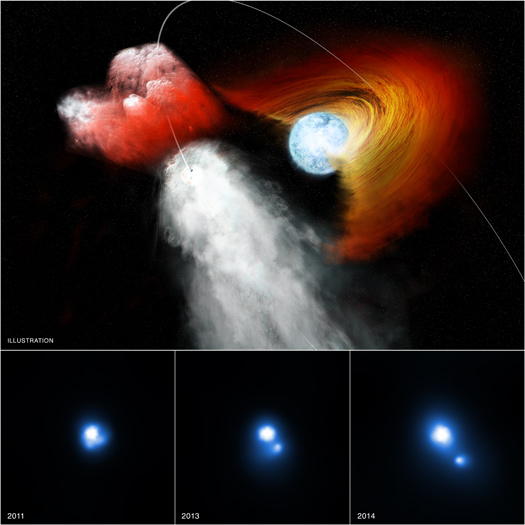Milky Way's Black Hole Shows Signs of Increased Chatter
Three orbiting X-ray telescopes have been monitoring the supermassive black hole at the center of the Milky Way galaxy for the last decade and a half to observe its behavior. This long monitoring campaign has revealed some new changes in the patterns of this 4-million-solar-mass black hole known as Sagittarius A* (Sgr A*).
Interning with Chandra

Alicia Goldstein
We welcome Alicia Goldstein, who was an intern at the Chandra X-ray Center this past summer, as our guest blogger. Ms. Goldstein, originally from Ellicott City, MD, is currently a senior at the University of Maryland, Baltimore County where she majors in mechanical engineering. Prior to this summer, Ms. Goldstein was an intern at NASA’s Goddard Space Flight Center and lists working for NASA as her ideal career goal.
This summer, I worked on two separate projects. The first involved the development of a Python code that would display the defined and predicted positions and velocities of Chandra, and the second involved the analysis of the periods of the variable stars in the Chandra Variable Guide Star Catalog,, or VGuide, database. The coding project involved interpreting and manipulating previous code, as well as creating entirely new sections. Given an input of two data files, the code was able to output a file with plots of the predicted and defined velocities and positions of the spacecraft.
A Carnival of Space Visits the Chandra Blog
Welcome to the latest installment of the Carnival of Space, a weekly round up of astronomy news co-hosted on various space science blogs. It’s a pretty big Universe out there so let’s get started!

Universe Today covers upcoming Full Moons and lunar eclipses, the funky structure on the asteroid Ceres that the Dawn spacecraft spotted, and the fascinating triple star system called 44 Boötis.
Happy First Light Anniversary!
Sixteen years ago today, the first images from the newly-launched Chandra X-ray Observatory were released to the public. While these images were spectacular themselves, they also represented the promise of the amazing things that Chandra might be able to do in the future.
Chandra Data Suggest Giant Collision Triggered "Radio Phoenix"
Astronomers have found evidence for a faded electron cloud "coming back to life," much like the mythical phoenix, after two galaxy clusters collided. This "radio phoenix," so-called because the high-energy electrons radiate primarily at radio frequencies, is found in Abell 1033. The system is located about 1.6 billion light years from Earth.
The Hunt for the Smallest Supermassive Black Holes

Vivienne Baldassare
We are very pleased to welcome Vivienne Baldassare as a guest blogger today. Vivienne is the first author of a paper that is the subject of our latest press release, about an exceptionally small supermassive black hole. She is a PhD candidate and National Science Foundation Graduate Research Fellow in the University of Michigan Department of Astronomy. Vivienne obtained her undergraduate degree in physics from Hunter College, where she was also a member of the Macaulay Honors College.
It is well established that most, if not all, massive galaxies host supermassive black holes at their centers − our own Milky Way houses a several million solar mass black hole in its core. Little is known, however, about the population of black holes in the centers of dwarf galaxies. I study the centers of small galaxies to see how many host supermassive black holes and if those black holes interact with their galaxies in the same way as bigger supermassive black holes.
Though dwarf galaxies are more common than large galaxies, it is more difficult to determine whether they host black holes. When galaxies are large and nearby, we can find central black holes by studying the motions of stars in the region dominated by the gravity of the black hole. Since smaller black holes influence smaller regions, this method would only work for dwarf galaxies in our cosmological back yard. Instead, we must search for active black holes in dwarf galaxies, i.e. black holes that are voraciously consuming material, releasing large amounts of light from the galaxy’s center.
Oxymoronic Black Hole Provides Clues to Growth
Astronomers using NASA's Chandra X-ray Observatory and the 6.5-meter Clay Telescope in Chile have identified the smallest supermassive black hole ever detected in the center of a galaxy, as described in our latest press release. This oxymoronic object could provide clues to how much larger black holes formed along with their host galaxies 13 billion years or more in the past.
A Disk-Shattering Discovery

Jeremy Hare
We are very pleased to welcome Jeremy Hare as a guest blogger today. Jeremy is a co-author of a study led by George Pavlov from Pennsylvania Statue University and Oleg Kargaltsev from George Washington University that is the subject of our most recent press release, on a binary system named LS 2883. Jeremy is about to begin his fourth year of graduate school at GWU working under Oleg Kargaltsev. He studies high-mass gamma-ray binaries, mainly in X-rays, and the classification of X-ray sources using machine learning. He tells us that LS 2883 was the first research project he worked on in graduate school and that it has been “very exciting to study!”
High mass gamma-ray binaries are rare objects in the Galaxy. These binaries consist of a massive star (usually with a mass greater than 10 solar masses) and a compact object, a neutron star or black hole. Many high-mass stars have a disk of material around them, which the compact object can interact with as it nears the star in its (often elliptical) orbit. High-mass gamma-ray binaries can accelerate particles to extreme energies of 10 TeV (=1012 electron volts, or eV) or higher, which is comparable to the energies that are currently being produced at the Large Hadron Collider. These particles then scatter off of lower energy photons (packets of electromagnetic energy that make up light) produced by the star, transferring some of their energy and boosting the photon’s energy to the GeV (109 eV) and TeV energy range.
Chandra’s "Sweet 16"!

More information at https://chandra.harvard.edu/16th/index.html
Birthdays can be a lot of fun and most teenagers can’t wait to turn sixteen. After all, this birthday often marks new adventures and opportunities (not to mention, maybe a party!)
Today we are celebrating the “sweet 16th” birthday not of a person, but of NASA's Chandra X-ray Observatory. On July 23, 1999, Chandra was launched into space aboard the Space Shuttle Columbia and has been working diligently to explore the high-energy Universe ever since.





